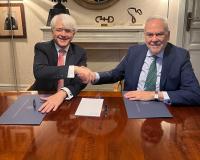
1.- Hechos.
La sentencia trae causa de una cuestión prejudicial planteada en Polonia en el contexto de un litigio entre Harman International Industries Inc. y AB S.A. por infracción de las marcas de la Unión JBL y HARMAN.
Harman, grupo internacional fabricante de altavoces, auriculares y sistemas de audio, interpuso acción judicial para impedir la venta en Polonia por AB de sus productos porque estos habían sido adquiridos a un proveedor distinto del distribuidor autorizado por la demandante en ese mercado.
El objeto de la acción era que se prohibiera a AB, con carácter general, la introducción o la comercialización, la importación, la oferta, la publicidad y el almacenamiento con estos fines de altavoces y auriculares, así como de sus embalajes, que lleven dichas marcas, que no hayan sido comercializados en el Espacio Económico Europeo (EEE) con carácter previo por Harman o con su consentimiento. Además, Harman solicitó que se ordenara a AB la retirada del mercado y la destrucción de dichos productos y sus embalajes.
AB se opuso a esta acción alegando el principio del agotamiento del derecho conferido por la marca e invocando, en esencia, la garantía recibida por su proveedor de que la importación de los productos en el mercado polaco no viola las marcas de Harman en la medida en que dichos productos habían sido comercializados en el EEE por Harman o con su consentimiento.
El órgano jurisdiccional remitente señaló que los sistemas de marcado de los productos empleados por Harman no resultan siempre suficientes para identificar el mercado de destino de cada uno de sus productos. Para determinar con certeza si un producto concreto estaba destinado al mercado del EEE, debe recurrirse necesariamente a una base de datos perteneciente a Harman.
Según dicho órgano jurisdiccional, AB podría dirigirse en teoría a su proveedor para obtener información acerca de la identidad de los operadores que intervinieron en las fases anteriores de la cadena de distribución. Sin embargo, considera que, dado que normalmente los proveedores no están dispuestos a divulgar sus fuentes de suministro para no perder ventas, es poco probable que AB consiga obtener este tipo de información.
El problema que subyace en la cuestión prejudicial planteada parte de la práctica de los órganos jurisdiccionales polacos consistente en incluir, en el fallo de sus resoluciones estimatorias de acciones por violación de una marca de la Unión, una referencia a los «productos que no han sido comercializados previamente en el EEE por la parte demandante (titular de la marca de la Unión) o con su consentimiento». Esta formulación no permite, en la fase del procedimiento de ejecución forzosa, identificar los productos a los que se refiere dicho procedimiento, respecto de los productos comprendidos en la excepción relativa al agotamiento del derecho conferido por la marca. En consecuencia, el fallo de dichas resoluciones no difiere, en realidad, de la obligación general que ya se desprende de las disposiciones de la Ley. Y en el proceso de ejecución el condenado parece disponer de posibilidades de defensa más limitadas.
El Tribunal de Justicia considera que, mediante su única cuestión prejudicial, el órgano jurisdiccional remitente pregunta, en esencia, si el artículo 15, apartado 1, del Reglamento 2017/1001, en relación con el artículo 36 TFUE, segunda frase, el artículo 47 de la Carta y la Directiva 2004/48, debe interpretarse en el sentido de que se opone a una práctica judicial según la cual el fallo de la resolución estimatoria de una acción por violación de una marca de la Unión está redactado en términos que, debido a su carácter general, dejan a la autoridad competente para la ejecución forzosa de esa resolución la tarea de determinar cuáles son los productos a los que se aplica dicha resolución.
2.- Pronunciamientos.
La sentencia empieza por señalar que la cuestión planteada debe entenderse en el sentido de que abarca tres partes. La primera se refiere al agotamiento del derecho conferido por la marca de la Unión y a las exigencias derivadas de la protección de la libre circulación de mercancías. La segunda versa sobre los requisitos que deben cumplir, con arreglo a la Directiva 2004/48, todas las medidas, procedimientos y recursos necesarios para garantizar el respeto de los derechos de propiedad intelectual. La tercera tiene por objeto la obligación de los Estados miembros, por un lado, de establecer las vías de recurso necesarias para garantizar la tutela judicial efectiva en un ámbito cubierto por el Derecho de la Unión y, por otro, de garantizar las condiciones de un proceso equitativo con arreglo al artículo 47 de la Carta.
En lo que respecta a la primera parte de la cuestión el TJ ofrece un repaso exhaustivo a la doctrina jurisprudencial sobre las importaciones paralelas y el agotamiento del derecho de marcas, con sus requisitos y limitaciones. Recuerda la sentencia que el agotamiento es sólo “comunitario”, no internacional; que el consentimiento debe ser explícito; y cuáles son las reglas que rigen en materia de la carga de la prueba y su modificación cuando estamos ante un sistema de distribución exclusiva.
Según la Sentencia, del artículo 15, apartado 1, del Reglamento 2017/1001, interpretado a la luz del artículo 36 TFUE y de la jurisprudencia del Tribunal de Justicia citada en los apartados 38 a 40 de la presente sentencia, se desprende que el operador que se enfrente a una acción por violación de marca ejercitada por el titular de una marca de la Unión tiene derecho, para oponerse a esta acción, a invocar y probar que los productos designados con dicha marca a los que se refiere la acción han sido comercializados en el EEE por ese titular o con su consentimiento. Dicho operador también debe poder beneficiarse de una modificación de la carga de la prueba en su favor cuando concurren los requisitos establecidos a este respecto por la jurisprudencia del Tribunal de Justicia. Pero el titular de la marca, añade la sentencia, no está obligado a adoptar un sistema de marcado de sus productos que permita determinar, respecto de cada producto, si estaba destinado al mercado del EEE.
En cuanto a la segunda parte de la cuestión, el TJ recuerda que todo procedimiento nacional relativo a una acción por violación de una marca de la Unión debe respetar las disposiciones de la Directiva 2004/48, pero que el aspecto procesal que constituye el objeto específico de la cuestión prejudicial planteada por el órgano jurisdiccional remitente en este asunto no se rige por la Directiva 2004/48, ya que esta no contiene ninguna disposición sobre la formulación del fallo de las resoluciones judiciales relativas a las acciones por violación de marca. Por lo tanto, esta cuestión está comprendida en el ámbito de aplicación del principio de autonomía procesal, a salvo de lo que se dirá a continuación.
La tercera parte de la cuestión la dedica el TJ a examinar si el hecho de que, en la fase de ejecución forzosa, la parte demandada disponga, con arreglo al Derecho nacional, de vías de recurso y de garantías procesales “limitadas” resulta contrario a las exigencias de la tutela judicial efectiva impuestas por el Derecho de la Unión y, en consecuencia, a la unidad y a la eficacia de ese Derecho.
En este punto la Sentencia ofrece un preciso repaso de la jurisprudencia existente sobre el derecho a la tutela judicial efectiva, el principio de igualdad de armas, el derecho de defensa, el principio de equivalencia, el principio de efectividad y el principio de seguridad jurídica y el buen desarrollo del procedimiento.
Para el TJ un operador que almacene productos comercializados en el EEE con una marca de la Unión por el titular de dicha marca o con su consentimiento tiene derechos que emanan de la libre circulación de mercancías, garantizada por los artículos 34 TFUE y 36 TFUE y el artículo 15, apartado 1, del Reglamento 2017/1001, que los tribunales nacionales deben salvaguardar.
No obstante, a la luz del principio de autonomía procesal, el Derecho de la Unión no puede oponerse a una práctica judicial según la cual el fallo de la resolución estimatoria de una acción por violación de una marca de la Unión está redactado en términos generales, siempre que la parte demandada disponga de una tutela judicial efectiva.
Por consiguiente, si el órgano jurisdiccional nacional está obligado a designar, en el fallo de sus resoluciones estimatorias de una acción por violación de una marca de la Unión, mediante una formulación general, los productos que no han sido comercializados anteriormente en el EEE por el titular o con su consentimiento, la parte demandada debe disfrutar, en la fase de ejecución forzosa, de todas las garantías de un proceso equitativo para poder impugnar eficazmente la existencia de una violación o de una amenaza de violación de los derechos exclusivos del titular de la marca y oponerse a la incautación de los ejemplares de los productos respecto de los cuales se han agotado los derechos exclusivos del titular y que, por tanto, pueden circular libremente en el EEE.
Por lo que atañe a la circunstancia indicada por el órgano jurisdiccional remitente de que, sin acceso a las bases de datos de Harman, no es objetivamente posible para AB demostrar que los productos que adquirió habían sido comercializados en el EEE por Harman o con el consentimiento de esta, podría resultar necesario, incluso en la hipótesis de que no se aprecie la existencia de una distribución exclusiva, que la autoridad competente para la ejecución forzosa o, según los casos, el órgano jurisdiccional competente para pronunciarse sobre los recursos interpuestos contra los actos que emanan de esa autoridad procedan a modificar la carga de la prueba, en la medida en que constaten, en función de las circunstancias específicas relativas a la comercialización de los productos en cuestión, que la regla de la carga de la prueba recordada en el apartado 50 de la presente sentencia puede permitir que el titular compartimente los mercados nacionales, favoreciendo así el mantenimiento de las diferencias de precios que puedan existir entre los Estados miembros.
Habida cuenta de todas las consideraciones anteriores, la sentencia responde a la cuestión prejudicial planteada declarando que el artículo 15, apartado 1, del Reglamento 2017/1001, en relación con el artículo 36 TFUE, segunda frase, el artículo 47 de la Carta y la Directiva 2004/48, debe interpretarse en el sentido de que no se opone a una práctica judicial según la cual el fallo de la resolución estimatoria de una acción por violación de una marca de la Unión está redactado en términos que, debido a su carácter general, dejan a la autoridad competente para la ejecución forzosa de esa resolución la tarea de determinar cuáles son los productos a los que se aplica dicha resolución, siempre que, en el marco del procedimiento de ejecución forzosa, se permita a la parte demandada impugnar la determinación de los productos a los que se refiere dicho procedimiento y que un órgano jurisdiccional pueda examinar y decidir, ajustándose a lo dispuesto en la Directiva 2004/48, qué productos han sido efectivamente comercializados en el EEE por el titular de la marca o con su consentimiento.
3.- Comentario.
Una práctica jurisdiccional de los tribunales polacos, que no parece que pudiera producirse en España, sirve de pretexto para que el Tribunal de Justicia proporcione una recapitulación exhaustiva de su jurisprudencia en materia no sólo de importaciones paralelas sino de los principios fundamentales de cualquier proceso judicial.
El problema que subyace en el caso, por el contrario, es el propio de cualquier pleito por importaciones paralelas: la prueba de si las mercancías fueron comercializadas en el EEE por el titular de la marca o con su consentimiento, esto es, si estaban destinadas en origen o no al mercado europeo.
La práctica jurisdiccional polaca, con la posibilidad para el Tribunal de condenar por infracción de marca sobre la base de una declaración genérica, pero sin concretar los productos a que está dirigida, parece que libera al titular de la marca de toda carga de la prueba. Y al posponer la concreción del alcance de la condena a la fase de ejecución impide al demandado articular su defensa por las menores posibilidades de prueba que contempla la normativa polaca en esa sede. Todo ello en el contexto de las dificultades de prueba que el caso presenta al carecer el producto del demandante de un sistema de marcado con indicación de destino.
El Tribunal de Justicia, en un terreno tan espinoso como el de conciliar los derechos de los titulares de marcas con el principio esencial de la libre circulación de mercancías en el seno de la Unión Europea, adopta una posición ecléctica: no hay nada objetable desde la perspectiva del Derecho de la Unión a ese tipo de pronunciamientos judiciales, por ser el fallo de las sentencias materia procesal nacional. Eso sí, siempre que en el proceso de ejecución se pueda deslindar probatoriamente el alcance concreto de la condena a aquellas mercancías que hubiesen sido efectivamente comercializados en el EEE por el titular de la marca o con su consentimiento.
Nota: Estimado lector este comentario jurisprudencial procede del Anuario Elzaburu. Usted podrá acceder al resto de comentarios del Anuario que se hallan publicados en el portal de Elzaburu (https://elzaburu.com/) para lo cual solo tendrá que incluir en el apartado Buscar 🔍 del portal el término Anuario Elzaburu para así poder acceder a los contenidos ya publicados.
VERSIÓN EN INGLÉS
- Parallel imports: general doctrine, identification of goods and judgment enforcement. Judgment of the Court of Justice of 17 November 2022, HARMAN (C-175/21).
1.-Background.
The judgment concerns a request for a preliminary ruling made by a Polish court in the context of proceedings between Harman International Industries Inc. and AB S.A. for infringement of the EU trademarks JBL and HARMAN.
Harman, an international group that manufactures speakers, headphones and audio systems, brought an action to prevent the sale of its products in Poland by AB because they had been acquired from a supplier other than the distributor authorized by the plaintiff for that market.
The action sought to prohibit AB, in general, from introducing or putting on the market, importing, offering, advertising and stocking, for those purposes, speakers and headphones and their packaging bearing the plaintiff’s marks which had not previously been placed on the market within the European Economic Area (EEA) by Harman or with its consent. Moreover, Harman requested that the court order AB to withdraw from the market and destroy those goods and their packaging.
In its defence, AB relied on the principle of exhaustion of the rights conferred by the trademark and invoked, in essence, the assurance received from its supplier that the importation of the goods onto the Polish market did not infringe Harman’s trademarks as they had been placed on the market in the EEA by Harman or with its consent.
The referring court noted that the systems for marking the goods used by Harman are not always sufficient to identify the destination market of each product. In order to determine with certainty whether a specific product was destined for the EEA market, it would be necessary to have access to a database belonging to Harman.
According to the referring court, AB could theoretically approach its supplier to seek information concerning the identity of the operators with involvement upstream in the distribution chain. However, it considered that since suppliers are usually unwilling to divulge their supply sources in order not to lose sales, it is unlikely that AB would be able to obtain this kind of information.
The problem underlying the question referred for a preliminary ruling stems from the practice of the Polish courts of including, in the operative part of their judgments upholding actions for infringement of an EU trademark, a reference to ‘goods which have not previously been put on the market in the EEA by the plaintiff (the proprietor of the EU trademark) or with its consent’. That wording does not make it possible, at the stage of enforcement proceedings, to identify the goods covered by those proceedings, with respect to the goods covered by the exception relating to the exhaustion of the rights conferred by the trademark. Consequently, the operative part of those judgments does not in fact differ from the general obligation that already follows from the provisions of law. And in the enforcement proceedings, the defendant appears to have more limited possibilities of defence.
The Court of Justice considers that by its sole question, the referring court is essentially asking whether Article 15(1) of Regulation 2017/1001, read in conjunction with the second sentence of Article 36 TFEU, Article 47 of the Charter of Fundamental Rights and Directive 2004/48, must be interpreted as precluding a judicial practice according to which the operative part of the judgment upholding an action for infringement of an EU trademark is drafted in terms which, because of their general nature, leave it to the authority with competence to enforce that judgment to determine to which goods that judgment applies.
2.- Findings.
The judgment begins by stating that the question referred should be understood as comprising three parts. The first part concerns the exhaustion of the rights conferred by the EU trademark and the requirements arising from the protection of the free movement of goods. The second part concerns the requirements that must be satisfied, in accordance with Directive 2004/48, by all the measures, procedures and remedies necessary to ensure the enforcement of intellectual property rights. The third part concerns the obligation of the Member States, on the one hand, to establish the legal remedies necessary to ensure effective judicial protection in an area covered by EU law and, on the other hand, to guarantee the conditions for a fair trial, in accordance with Article 47 of the Charter of Fundamental Rights.
With regard to the first part of the question, the CJ offers an exhaustive review of the case-law on parallel imports and the exhaustion of trademark rights, and the requirements and limitations. The judgment recalls that exhaustion is only within the Community and not international, that there must be express consent and it recalls the rules governing the burden of proof and changes to those rules where there is an exclusive distribution system.
According to the judgment, it follows from Article 15(1) of Regulation 2017/1001, read in the light of Article 36 TFEU and the case-law of the Court of Justice cited in paragraphs 38 to 40 of the judgment, that a trader facing an infringement action brought by the proprietor of an EU trademark has the right, for purposes of defence, to allege and prove that the goods bearing that trademark referred to in the infringement action, were placed on the market in the EEA by that proprietor or with the proprietor’s consent. That trader must also be able to benefit from a reversal, in its favour, of the burden of proof where the conditions established in the case-law of the Court of Justice in that regard are met. However, the judgment adds that the trademark proprietor is not obliged to adopt a marking system for its products that makes it possible to determine, with respect to each product, whether it was destined for the EEA market.
As for the second part of the question, the CJ recalls that any national procedure relating to an action for infringement of an EU trademark must comply with the provisions of Directive 2004/48, but that the procedural aspect that is the specific object of the referring court’s question in this case is not governed by Directive 2004/48, as said directive does not contain any provision concerning the formulation of the operative part of judicial decisions relating to trademark infringement actions. This question therefore falls within the scope of application of the principle of procedural autonomy, subject to the following.
The third part of the question is dedicated by the CJ to examining whether the fact that, at the enforcement stage, the defendant has, under national law, ‘limited’ legal remedies and procedural guarantees is contrary to the requirements of effective judicial protection imposed by EU law and, consequently, to the unity and effectiveness of that law.
In this regard, the judgment offers a precise review of the existing case-law on the right to effective judicial protection, the principle of equality of arms, the right of defence, the principle of equivalence, the principle of effectiveness and the principle of legal certainty and the proper conduct of the proceedings.
For the CJ, a trader that holds goods bearing an EU trademark placed on the market in the EEA by the proprietor of that trademark or with said proprietor’s consent, derives rights under the free movement of goods, guaranteed by Article 34 TFEU and Article 36 TFEU and Article 15(1) of Regulation 2017/1001, which the national courts must safeguard.
However, with regard to the principle of procedural autonomy, EU law cannot preclude a judicial practice whereby the operative part of a decision upholding an action for infringement of an EU trademark is drafted in general terms, provided that effective judicial protection is available to the defendant.
Therefore, if the national court is required to designate, in the operative part of its decisions upholding an action for infringement of an EU trademark, by means of a general formulation, the goods which were not previously put on the market in the EEA by the trademark proprietor or with its consent, the defendant should, at the enforcement stage, be afforded all the guarantees of a fair hearing in order to be able to effectively contest the existence of an infringement or threat of an infringement of the trademark proprietor’s exclusive rights and challenge the seizure of those goods in respect of which the trademark proprietor’s exclusive rights have been exhausted and which may therefore freely circulate within the EEA.
With regard to the circumstance pointed out by the referring court that, without access to Harmann’s databases, it is not objectively possible for AB to demonstrate that the goods it purchased had been placed on the market in the EEA by Harmann or with its consent, it may be necessary, even where no exclusive distribution is found to exist, for the competent enforcement authority or, as the case may be, the court with jurisdiction to rule on appeals brought against the acts of that authority, to reverse the burden of proof, to the extent that the authority or court finds, depending on the specific circumstances relating to the marketing of the goods in question, that the rule on the burden of proof, recalled in paragraph 50 of the judgment, is liable to allow the trademark proprietor to partition national markets and thus help to maintain price differences which may exist between Member States.
In the light of all the above considerations, the judgment responds to the question referred for a preliminary ruling, indicating that Article 15(1) of Regulation 2017/1001, read in conjunction with the second sentence of Article 36 TFEU, Article 47 of the Charter of Fundamental Rights and Directive 2004/48, must be interpreted as not precluding a judicial practice by which the operative part of the decision upholding an action for infringement of an EU trademark is drafted in terms which, due to their general nature, leaves it to the authority competent to enforce that decision to determine the goods to which that decision applies, provided that, in the context of the enforcement procedure, the defendant is permitted to challenge the determination of the goods covered by that procedure and that a court may examine and decide, in accordance with the provisions of Directive 2004/48, which goods have in fact been placed on the market in the EEA by the trademark proprietor or with its consent.
3.- Remarks.
A practice of the Polish courts, which does not seem likely to occur in Spain, serves as a pretext for the Court of Justice to provide an exhaustive review of its case-law on the subject not only of parallel imports but also of the fundamental principles of any judicial process.
The underlying issue in this case, however, is the same as in any case of parallel imports: proving whether the goods were put on the market in the EEA by the trademark proprietor or with its consent, that is, whether or not they were originally intended for the European market.
The practice of the Polish courts, where there is a possibility for the court to convict for trademark infringement on the basis of a generic statement, but without specifying to which goods it applies, appears to relieve the trademark proprietor of any burden of proof. And by postponing the determination of the scope of the conviction to the enforcement stage, the defendant is prevented from articulating its defence due to the limited possibilities for proof provided for in Polish law at that stage. All of this in the context of the difficulties concerning proof that this case presents given the absence of a marking system for the plaintiff’s product indicating the destination.
The Court of Justice, in such a thorny area as reconciling the rights of trademark proprietors with the essential principle of the free movement of goods within the European Union, adopts a somewhat eclectic position: there is nothing objectionable from the standpoint of EU law with regard to this kind of judicial ruling, since the operative part of judgments is a matter of national procedure. However, this is provided that in the enforcement proceedings, the specific scope of the conviction can be established on the basis of evidence in relation to those goods that have actually been put on the market in the EEA by the trademark proprietor or with its consent.
ElDerecho.com no comparte necesariamente ni se responsabiliza de las opiniones expresadas por los autores o colaboradores de esta publicación








